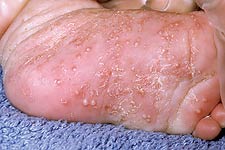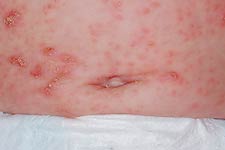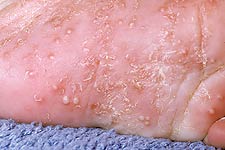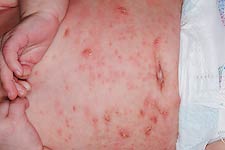An 8-month-old girl with a pruritic eruption
This 8-month-old girl presented to the clinic with a pruritic eruption for six weeks that was progressively worsening.
Initially, she had a few small erythematous papules on the chest but they have spread to include the axillae, abdomen and extremities.


At first, her mother thought it was eczema and used petroleum jelly daily on the affected areas, which provided minimal relief of the pruritus only. On examination, the infant was playful but intermittently scratched the lesions. On examination, multiple eroded and crusted erythematous papules, papulovesicles and small pustules over the trunk and axillae are noticed.
What is your diagnosis?
Answer
The diagnosis is scabies.
Scabies is caused by the mite, Sarcoptes scabiei, an obligate parasite to humans. Scabies is usually spread by intimate contact between people. The mites have a life cycle lasting about 30 days, which begins when a fertilized female burrows into the stratum corneum (top layer of epidermis). She deposits both eggs and fecal pellets (scybala) into the burrow as she moves forward. The larvae hatch and mature over 14 to 17 days. The adults mate, the males die and the cycle begins again. Migration of the mites, as well as scratching individual lesions, leads to spread of the infestation so that a once-localized rash can develop into a widespread eruption as seen in this patient.
The pruritus is due in part to the feces causing irritation. Nocturnal pruritus is particularly common in patients with scabies. The pruritic papules, however, are thought to be due to a type 1 hypersensitivity response to the mite rather than a local reaction to foreign material. It may take up to four to six weeks for the hypersensitivity to develop with the first exposure. In contrast, with re-exposure, hypersensitivity and therefore pruritus occurs over the first few days. Infants seem to react more quickly and severely.


Lesions appear as pinpoint papules and discrete vesicles. Burrows are thread-like white linear or s-shaped lesions ranging from 2-15 mm in length: with magnification, you may see a vesicle or the actual mite appearing as a black dot at the end.
In older children and adults, scabies is classically found in intertriginous spaces like finger and toe webs, flexural surfaces of the wrists and elbows, knees, and ankles. Adolescents and adults may have involvement of the breasts and groin region. Infants, in particular, often have a more diffuse distribution, may have vesicles or pustules on the palms and soles, and are more likely to have involvement of the face and scalp. In addition, they are more likely to develop secondary eczematization or impetiginization with more diffuse involvement. Differential diagnosis includes atopic dermatitis, infantile acropustulosis, insect bites, papular urticaria, seborrheic dermatitis, palmoplantar psoriasis and dermatitis herpetiformis.
Diagnosis
Diagnosis is usually clinical and is based on history and physical exam. Often several family members will complain of a similar pruritic rash. However, there are different degrees of reaction to the mite and symptoms will vary between individuals. Definitive diagnosis can be made by unroofing and scraping an intact burrow and demonstrating mites, eggs, egg casings, or scybala under the microscope. This is best achieved by placing a drop of mineral oil over the lesion and scraping gently with a #15 blade and viewing the scrapings on a slide with a cover slip.
The treatment of choice is permethrin 5% cream, applied from the neck down but including the face and scalp in young children. It is washed off eight to 12 hours later. Permethrin, a synthetic pyrethrin, is an arthropod neurotoxin that paralyzes the mites. One dose provides cure rates of 89% to 92%, but a second treatment one week later is generally standard practice. An alternative treatment is 6% to 10% precipitated sulfur in petrolatum. Sulfur is the treatment of choice for infants less than 2 months of age and pregnant women and is applied for three consecutive nights and washed off 24 hours after each application. However, there are no safety or efficacy data for sulfur. It is safe to prescribe topical sulfur for patients with sulfa allergy. Ivermectin, off-label, has also been used safely and effectively in children with scabies at a dose of 200 mcg/kg with a repeat dose given at 10 to 14 days. The AAP cautions against using ivermectin in children younger than age 2 or weighing less than 15 kilograms.
Patients should be aware that they may continue to have pruritus for about six weeks after treatment likely due to the hypersensitivity response. Some children develop crops of sterile pustules on the hands and feet termed post-scabetic acropustulosis which can be confused with recurrent scabies. All household and other skin-to-skin contacts must be treated as well. It is imperative to share with families the importance of washing all towels and bed linens as well as vacuuming and cleaning carpets, chairs and couches since mites can live on fomites for several days and up to seven days in mineral oil. Pruritus can be treated with anti-histamines or topical steroids if excematization has occurred. Systemic steroids are rarely indictated unless there is intractable pruritus and are generally avoided in pediatric patients with scabies. Secondary infection should be treated with antibiotics.
For more information:
- Habif, Thomas P. Clin Dermatology: A Color Guide to Diagnosis and Therapy. Philadelphia: Mosby, 2004;pp 497-505.
- Leone PA. Scabies and Pediculosis Pubis: An Update of Treatment Regimens and General Review. Clin Infect Dis. 2007 Apr 1;44 Suppl 3:S153-9.
- Mancini AJ, Frieden IJ, Paller AS. Infantile acropustulosis revisited: history of scabies and response to topical corticosteroids. Pediatr Dermatol. 1998 Sep-Oct;15(5):337-41.
- Meinking Tl, Eglart GW. Scabies therapy for the millennium.Pediatr Dermatol. 2000 Mar-Apr;17(2):154-6.
- Morgan-Glenn PD. Scabies. Pediatr Rev. 2001 Sep;22(9):322-3.
- Orion E, Marcos B, Davidovici B, Wolf R. Itch and scratch: scabies and pediculosis. Clin Dermatol. 2006 May-Jun;24(3):168-75.
